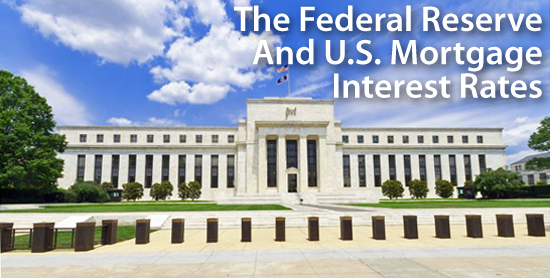About The Federal Reserve, The FOMC, & The Fed Funds Rate

What Is The Federal Reserve?
The Federal Reserve is the central banker of the United States of America and the group has a dual charter. The first charter of "the Fed" is to foster maximum employment within the U.S. economy. The second charter is to seek price stability.
"Price stability" is measured as inflation. Inflation is the rate at which the cost of items change within the U.S. economy. Another way to consider inflation is in terms of the U.S. dollar and its devaluation.
When inflation is present in the economy, consumer dollars "don't go as far"; more dollars are required to purchase the same amount of goods and services.
Rising rates of inflation are linked to rising mortgage rates.
The Federal Reserve aims to keep inflation near 2 percent annually. Inflation rates exceeding two percent can be damaging to the U.S. economy. So can inflation rates below two percent.
Furthermore, inflation rates have the potential to go negative. This is known as deflation, or disinflation.
Deflation is linked to falling mortgage interest rates.
Click for today's mortgage rates.
The Federal Open Market Committee (FOMC)
Within the Federal Reserve is a 12-person, policy-setting committee called the Federal Open Market Committee (FOMC). Annually, there are eight scheduled meetings of the FOMC.
After each meeting, the Fed makes a press release known as the "FOMC Statement" which summarize the central banker's policy choices.
The most widely-known FOMC monetary policy choice is its setting of the Federal Funds Rate. The Fed Funds Rate is the rate at which banks borrow money from each other overnight.
When the Fed votes to raise Fed Funds Rate is increased, costs rise for consumers and businesses which creates a drag on the U.S. economy. Conversely, when the FOMC votes to lower the Fed Funds Rate, the economy is pushed toward expansion.
The Fed Fund Rate is also the basis for "Prime Rate", a key interest rate for consumers and U.S. businesses. Prime Rate is used to set credit card interest rates and the cost of business loans.
Prime Rate is generally equal to the Fed Funds Rate plus three percent.
The Federal Reserve uses other tools to influence U.S. economic growth, too, including Discount Rate, which is the overnight interest rate at which banks can borrow money from the Federal Reserve; and special programs such as quantitative easing.
Quantitative easing is a process via which the Fed purchases securities in the open market in order to lower yields and consumer mortgage rates.
The FOMC has used a quantitative easing program three times since 2009 and, each time, the result was lower mortgage rates. The Fed's second QE program coincided with the lowest, recorded 30-year mortgage rates in history.
The Fed's third round of quantitative easing -- commonly called QE3 -- had a similar effect on rates. However, it's important to recognize that the Fed's effect on mortgage rates is indirect. The Fed does not set consumer mortgage rates.
Mortgage rates are made on Wall Street.
The Fed Does Not Set U.S. Mortgage Rates
The Federal Reserve does not control mortgage rates directly. However, it often influences the direction in which mortgage rates move. This is because, as the nation's central banker, the Fed's actions and its rhetoric are closely watched by Wall Street.
"Actions" that the Fed can take include its setting of the Fed Funds Rate and the Discount Rate; and establishing programs such as quantitative easing.
It's the setting of the Fed Funds Rate, though, which is the Fed's most well-known tool. When the Fed votes to increase or decrease the Fed Funds Rate, it's sending very specific messages to Wall Street.
When the Fed Fund Rate is raised, for example, it's a signal that inflationary pressures are growing within the U.S. economy, which often suggests an economic expansion.
Mortgage rates tend to rise on actions such as this for two reasons.
The first reason is that inflation devalues mortgage bonds, which results in a broader-market sell-off.
The second reason is that an expanding economy attracts investment dollars towards equity markets and away from bonds. As demand for mortgage-backed bonds drops, assuming constant supply, mortgage rates rise.
Even when the Fed votes to hold the Fed Funds Rate unchanged, mortgage rates can move. This is because Wall Street responds to Fed rhetoric, too.
Comments from Federal Reserve members suggesting future Fed policy may change can lead mortgage rates higher or lower. Expansionary comments often lead rates up; contractionary comments often lead rates down. And such comments can hit markets at any time.
In between FOMC meetings, which occur every six weeks, members of the Federal Reserve speak to Wall Street, to business organizations, and to the press; offering opinions on the economy and future monetary policy.
The Fed also published the "Fed Minutes", which is a summary of the discussions and debates from the most-recent FOMC meeting. Fed Minutes are published three weeks after an FOMC meeting adjourns and often eclipse 8,000 words, providing plenty of market-changing fodder for Fed-watchers worldwide.
These comments affect opinion about stocks and bond markets, which causes mortgage rates to change.
Get Today's Mortgage Rates
The Fed doesn't tell U.S. banks where to set mortgage rates, but the central banker's actions certainly influence them. See where today's mortgage rates stack up, and whether you're eligible for the lowest rates of the day.
Rate quotes are available online at no cost and with no obligation to proceed. Your social security number is not required to get started, either.
Copyright Full Beaker, Inc. 2015